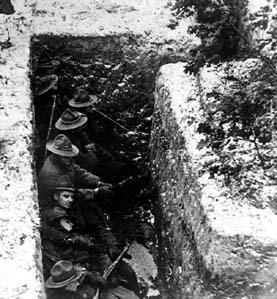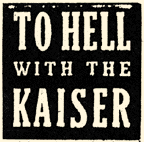By Sharon Boswell
and Lorraine McConaghy
Special to The Times

In the fall of 1917, the Second Washington Infantry's Seattle Battalion
paraded down First Avenue to encourage participation in the government's
Liberty Loan bond drive, raising money for the war effort.
Photo Credit: Seattle Times.
THE UNITED STATES ENTERED WORLD WAR I IN APRIL 1917,
nearly three years after hostilities broke out between the Central and Allied powers in Europe.
German U-boat warfare had raged against British and neutral shipping while
the Kaiser's armies struck overland against Belgium, France and Russia. Alliances pulled world powers
into the fighting one by one as the war spread from Europe to Africa, the Middle East and Asia.
In France, the opponents threw everything they had at one another until their armies ground
to a halt, digging in for years of trench warfare on the western front.
The war's images were shocking. Every day, the city's papers ran photographs of
the devastated fields and towns of France, the long columns of Russian refugees shuffling through
the snow, the packs of hungry orphans begging in Belgium. War correspondents and photographers
risked their lives to report the military stalemate for Seattle readers.
The papers brought home the grinding exhaustion and boredom of the muddy trenches
and the breathless rage and terror of combat.
After registration, Seattle's first draftees were chosen by lot
in the fall of 1917. The Seattle Times' editor-in-chief, C.B. Blethen, commandant
of the state's National Guard, had long preached the gospel of preparedness
on the paper's editorial pages. But as the American Expeditionary Force
trained to enter the war in Europe, The Times worried that American soldiers were poorly prepared.
 Seattle newspapers featured daily photographs of
the horror and the boredom of warfare. At right, American soldiers in France tried to doze
in their trench as snow dusted the ground in 1918.
Seattle newspapers featured daily photographs of
the horror and the boredom of warfare. At right, American soldiers in France tried to doze
in their trench as snow dusted the ground in 1918.
Photo Credit: Seattle Times
THE NEWSPAPER FEATURED COVERAGE OF EVERYDAY LIFE ON THE FRONT,
showing men smoking or playing pinochle. But American soldiers also suffered the
common miseries of trench-foot and trench-itch, of fever, diarrhea and tuberculosis;
they sustained horrible shrapnel wounds, they were gassed, and they entered the private
hell of shell shock. The newspaper didn't flinch from publishing photos of young men
in wicker-basket litters coming home to military hospitals.
When local boys went off to join Allied troops on the battlefront,
Seattle became just another city on the American homefront. Like everywhere else,
the city's German Americans found themselves under suspicion as spies
for the Kaiser's war machine. Washington banned the teaching of the German
language in high schools, and Seattle music-lovers gave up Wagner.
Like all Americans, Seattleites did without whiskey and beer,
and tightened their belts on Wheatless Mondays and Meatless Tuesdays.
They were urged, reminded, then badgered to finance the war by buying Liberty Bonds.
The state's industries mobilized to fight the war. Tough, light spruce
was in demand for many military uses, including the biplanes at William Boeing's fledgling company.
But in 1917, the labor movement's Wobblies were leading a paralyzing strike in the woods,
fighting dreadful working conditions.

The Times ran slogans such as "To Hell with the Kaiser" as space fillers
in both its news and advertising columns throughout the war.
WASHINGTON'S FORESTS WERE ESSENTIALLY NATIONALIZED for the duration,
and soldiers cut the timber crucial for war. Puget Sound shipyards built battleships,
transports and ships of every description, employing nearly 40,000 people in Seattle alone.
As war news broke, seattle's dailies printed extra editions and newsboys fanned
through the city to yell, "WUXTRA! WUXTRA! Yanks Gain at St. Mihiel!" In these years before radio,
the great plaza before The Seattle Times Building became the city's gathering place.
An elaborate code of whistle blasts brought people to Times Square on the run,
anticipating the news of a victory, a defeat or peace.
In the fall of 1918, an influenza epidemic swept the United States,
claiming 10 times the casualties of the battlefield. In Seattle, schools and theaters
were closed for more than five weeks as health authorities tried to quell the outbreak,
spread by G.I.s returning to Camp Lewis. Cautious people were afraid to leave their homes,
and joy at the war's end was muted by fear of crowds and disease.
World War I ended in November 1918, and the Pacific Northwest took stock.
Three million Allied soldiers had died -- nearly 800 from Washington state.
President Woodrow Wilson had posed the war to Americans as a moral
quest to make the world safe for democracy. But in Washington state, the war had claimed precious
lives, trampled civility and freedom, and disrupted the economy. There would be many reckonings.
Historians Sharon Boswell and Lorraine McConaghy teach at local universities
and do research, writing and oral history. Original newspaper graphics courtesy of the Seattle Public Library.